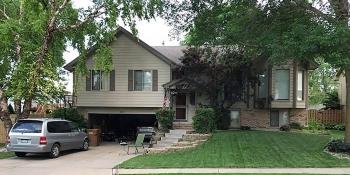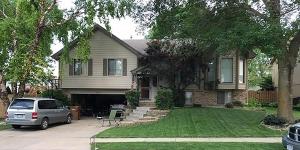Home is the Key stories
The U.S. housing crisis is increasing for communities in every region of the country. Read stories about how access to homeownership changes lives and creates welcoming communities.
The U.S. housing crisis is increasing for communities in every region of the country. Read stories about how access to homeownership changes lives and creates welcoming communities.
Regina and Larry’s search for a comfortable home led them to Habitat. The couple was approved for the homeownership program and immediately began volunteering and rooting themselves in their new community.
On any given day, it’s common for four generations of Larry and Regina’s family to drop into their home to share a meal, a story, a laugh. The couple, who married later in life, enjoy a large, blended family. After living in their community for nearly a decade, Larry and Regina have found that their neighbors have become like family, too.
Their front door, which Larry jokingly calls “a magnet,” is a constant carousel of friends, family and neighbors stopping by. Regina loves their open-door policy, especially when it means spending time with her children and grandchildren.
Before Larry and Regina moved into their “blessed home,” Regina lived alone in a bungalow with severe structural damage that would have required expensive renovations to the house’s foundation, roof and walls. The house also lacked proper insulation, making wintertime unbearable.
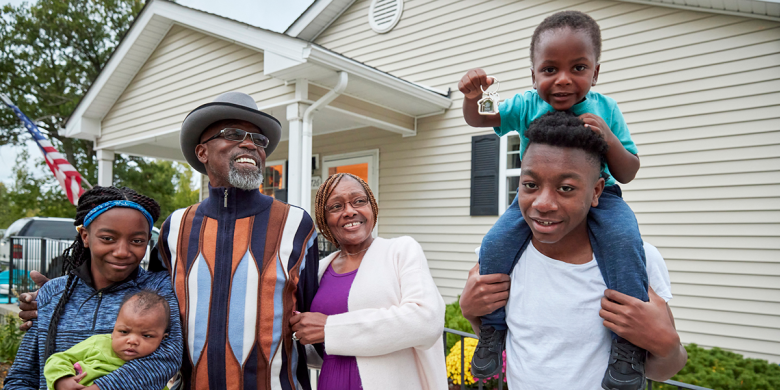
After realizing they wanted to spend the rest of their lives together, Regina and Larry decided to explore housing upgrades. Their search led them to Habitat for Humanity. The couple was approved for Habitat’s homeownership program and immediately began volunteering and rooting themselves in their new community. Larry and Regina marveled at the generosity and kindness of their neighbors during each home build.
“What Habitat did for me was remind me of what camaraderie is and what community is really about,” Regina says. “Habitat is a very important piece of togetherness.”
Larry and Regina adore their four-bedroom home and spacious backyard, which has been the site of many impromptu neighborhood parties, family reunions and Fourth of July celebrations. Most importantly, the ample space allows their four grandchildren — 17-year-old Xavier, 13-year-old Erin, 4-year-old Ja’Koi and 1-year-old Imunique — to comfortably stay with them.
“Our grandchildren know they have a place to come home,” Regina says. “Before, everything seemed so temporary. The foundation we laid here helps my family be more stable.”
Larry and Regina, both military veterans, have become community fixtures in their neighborhood. Homeownership has enabled the couple to invest in their home and community. Their next project is to install a playground set in their backyard for their grandchildren to enjoy — a move that’s sure to attract other kids from the neighborhood as well.
“Homeownership gives us power,” Larry says. “You can use your home to make things happen. Home is the key to success.”
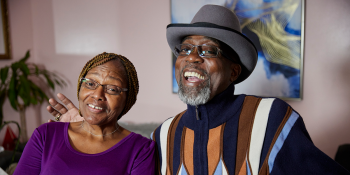

For Jessica, there has never been anything more important than providing a safe and secure home for her two children. Seeing her youngest crawling in an unhealthy home, Jessica says, “That was my breaking point where I said, ‘I need to make a move,’ and Habitat was that move.”
For Jessica, there has never been anything more important than providing a safe and secure home for her children, 16-year-old Amiyah and 2-year-old Noah. But the single mom struggled to find decent and affordable housing.
The family’s rental had a leaking roof, an unstable foundation and mice. “We were living in a house that was basically uninhabitable,” Jessica says. Their street had dilapidated homes, empty lots, few neighbors and crime.
It was after Noah was born that Jessica decided to make a change. “I think that was a pivotal moment for me, when I thought about this baby crawling in these conditions and putting things in his mouth,” Jessica says. “That was my breaking point where I said, ‘I need to make a move,’ and Habitat was that move.”
Once Jessica was accepted into Habitat for Humanity’s homeownership program, she and her children temporarily moved into her mother’s apartment so they could be in a safer environment.
While preparing to become a homeowner, Jessica enjoyed meeting future neighbors while working on the build site and found great value in Habitat’s homebuyer education classes. She can’t wait to apply what she learned in her new home. “I’ve had classes on budgeting, and I’ve had classes on home repairs and learning how to maintain your home,” she says. “I just feel like all those things are useful for someone like me who’s never owned a home before. I’m going to need those resources.”
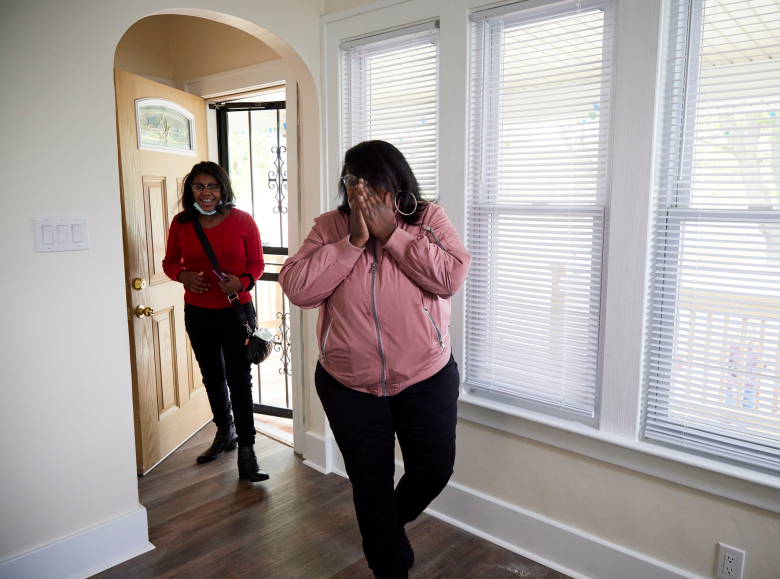
When she first walked through the front door of her Habitat home with Amiyah by her side, it felt like a whole new beginning. “I’m overwhelmed with joy,” Jessica says. “To see such happiness on my daughter’s face. She deserves it all.”
Amiyah is excited to finally have space to spread out and to be able to invite friends over. “To have my own room, my own privacy. Somewhere I can relax, just vibe and get stuff off my mind. Have friends come and sleep over. Everything a teenager usually would do,” she says.
Jessica is looking forward to having space to continue studying for her nursing degree, decorating her home, and hosting friends and family. Her new neighbors have already started reaching out and welcoming her into the community. “We’ve never had neighborhood gatherings and get-togethers,” she says. “I can definitely foresee those things happening here in this community.”
The stability and security that their new home provides means the world to Jessica. “This house, it’s everything to my family,” she says. “It’s the glue.”
Jessica hopes her experience with Habitat helps her children understand the importance of building generational wealth through homeownership and inspires them to reach toward their dreams, too. “To be able to show my daughter that it’s possible and to make her proud of me, that’s the biggest thing for me,” Jessica says. “The baby doesn’t have many memories, but this is what he’ll know. He’ll always know that mom was a homeowner. That’s all he’ll know, and that’s a good thing, too.”
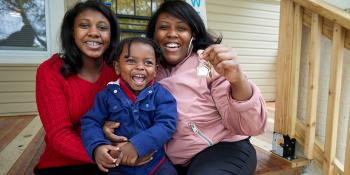
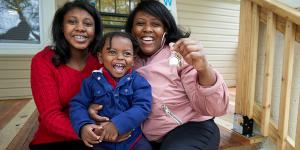
For Aretha, the accessibility features in her Habitat home “make a big difference” for her and her two children, 23-year-old Devin and 22-year-old Zacaya.
Wide doors and hallways, low cabinets, railings in the bathroom, a ramp on the front porch. For Aretha, the accessibility features in her Habitat for Humanity home “make a big difference” for her and her two children, 23-year-old Devin and 22-year-old Zacaya.
Aretha has cerebral palsy and uses a walker, and Devin and Zacaya both have a rare degenerative muscular condition that requires them to use wheelchairs. Their four-bedroom home gives the family the space and independence to thrive, but it wasn’t always that way.
Before partnering with their local Habitat affiliate, they were renting a small two-bedroom apartment unfit for a family with mobility challenges. Though Devin and Zacaya used walkers then, frequent elevator outages forced the family to climb several flights of stairs to reach their third-story apartment. Aretha feared the day when Devin and Zacaya would need to use wheelchairs and be unable to access the apartment.
Aretha was searching for a larger, ground-level apartment to rent when a friend suggested she explore homeownership opportunities with Habitat. Soon after she was accepted into the program, she began building her house alongside volunteers who traveled from out-of-state to support her dream of homeownership.
Aretha says she was overcome with emotion and pride when she and her kids first opened the door to their very own home in 2011. “It was the best feeling in the world. “I was able to show my children that they can do anything. Just because you’re disabled doesn’t mean you can’t get it done.”
The family’s Habitat home was designed with accessibility top of mind. The kitchen is spacious and has low, easy-to-reach cabinets. The bathroom is wide and equipped with hand railings near the toilet and shower. Each family member has their own bedroom. A smooth ramp leads up to their front door. The home also has no carpet, allowing Aretha, Devin and Zacaya to freely maneuver their wheelchairs and walkers from room to room.
The home’s adaptability and space offer the family more independence. Aretha says from the day they moved in Devin and Zacaya have loved having their rooms. It’s their own space for Zacaya to paint and Devin to play video games — hobbies they’re passionate about that also improve their motor functions.
If she hadn’t partnered with Habitat, Aretha says they likely would have moved in with family members and potentially sacrificed accessibility for affordability. Instead, Aretha pays an affordable mortgage for a comfortable, accessible home in a neighborhood she adores.
“Here, they can be independent,” Aretha says. “They can be more mobile. They can go outside. They can use the restroom on their own. This home is the key to independence and freedom for my children and me.”
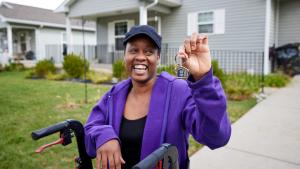
Finding a decent, affordable place to call home was an ongoing challenge for Donyelle, a public school employee for 38 years. “We were really in need of better housing,” Donyelle says.
As a public school employee for 38 years, Donyelle understands the importance of education. She has worked tirelessly to instill a desire for learning in each of her five children, but working a full-time job while being a widowed mother left little time for Donyelle to pursue her own higher education. To support her two girls and three boys, she dropped out of community college.
Finding a decent, affordable place to call home was an ongoing challenge. Donyelle and her children were priced out of a townhome when the rent started increasing every three months. In search of affordable housing, the family moved across town, but their two-bedroom rental was small and had mice. “We were really in need of better housing,” Donyelle says.
Pushing off going back to school, Donyelle feared that she’d fail to leave anything behind for her children.
A friend introduced Donyelle to Habitat for Humanity, and she was soon building her house alongside her future neighbors. She relished the time building her dream home — and building lasting friendships that would root her in her new neighborhood.
Donyelle and her three boys — her two oldest daughters had already left home — moved into their Habitat house in June 2009. She said she felt “pure bliss” walking through her door for the first time.
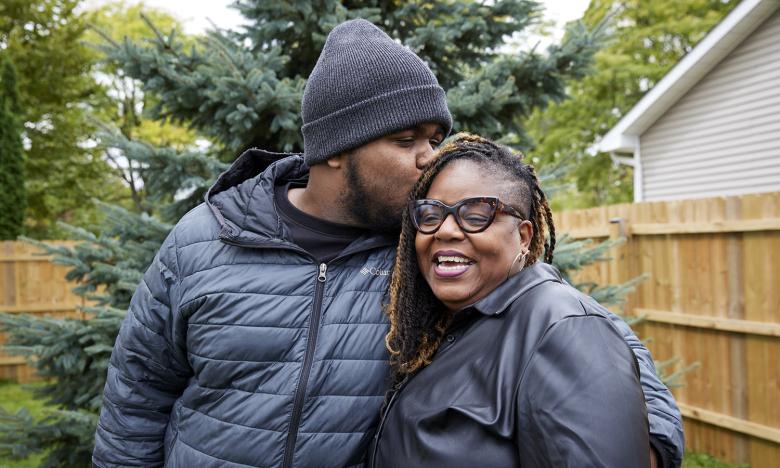
In August 2022, three months after her youngest son, Chance, graduated from college, Donyelle returned to school, earning her associate’s degree in general studies from a local community college.
Donyelle says homeownership was a catalyst for finishing her degree. “I wouldn’t have completed my education if I was not a homeowner,” she says. “I really feel that me being a homeowner, me being stable, me having a foundation was the basis for me being able to go back and complete my education and get my degree.”
“I think that it’s important that my children know that I’ve worked very hard all my life. To have a stable job, to have a stable home, it means a lot,” she continues. “It can take you far. It can give you advantages.”
Donyelle has remarried, and her husband has three children of his own. The couple love hosting their big, blended family. Donyelle, who calls herself a “fun grandmother,” finds unmatched pleasure in watching her six grandchildren play in her living room. It’s even sweeter knowing that she will be able to pass down the home that has been their key to a more secure future.
Donyelle says her home has provided the family with “a sense of pride and belonging.” Even as her children have grown up and built homes and families of their own, they know that the doors of their mother’s two-story Habitat house — where the words “Practice Kindness” adorn the front porch — will always be open.
“It’s a place where, no matter where they go in the world, they know they could always come home,” Donyelle says.
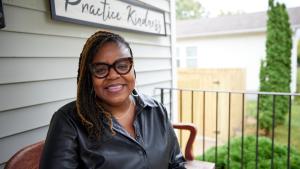
Thank you to the generous sponsors of the 2025 Jimmy & Rosalynn Carter Work Project.
Habitat-USAID/BHA’s Humanitarian Shelter and Settlements fellowship offered students a chance to deepen their research and boost their professional careers. Learn about the fellows who were part of this innovative program and their inspiring work.
“No matter where my kids go, when we talk about home, everybody’s heart is here,” says Peggy, a disabled U.S. Air Force veteran who was able to repair her family home with the support of Habitat and The Home Depot Foundation.
More than 20 years ago, Peggy and her children moved into the home of her dreams. The mother of three remembers teaching her kids to ride their bikes on the sidewalk in front of the house, sending them to the elementary school “right up the hill” and walking them to the park to play. “Every nook and cranny. Every flaw that somebody might point out, I can look at, and it’s a special memory,” says Peggy, a disabled U.S. Air Force veteran. “It became my home in such a personal, special way.”
Now that her children — 26-year-old U.S. Air Force pilot Connor, 24-year-old Jordan and 20-year-old Jonathon — are adults, Peggy had hoped to maintain a healthy home they could always return to. But as the years passed, her house began to require expensive repairs – like fixing a deteriorating roof – that Peggy couldn’t afford to make. A string of personal losses and the post-traumatic stress disorder she’d developed from her military service made it even more challenging for her to fix her home.
In 2017, a tornado struck Peggy’s neighborhood, accelerating the problems with her roof, and eventually water began saturating her walls and coming into her home. “I went through my dining room, my great room, the hallway and the back bedrooms, and there were water spots everywhere from water coming into the house through the roof,” Peggy says.
Peggy also needed to have her chimney repaired and her windows replaced. During Nebraska’s cold winters, she and her daughter, Jordan, would wrap up in blankets, gloves and scarves while sitting in front of the fireplace to stay warm because their home couldn’t hold heat. The mother and daughter both have a condition that causes blood flow to slow with even minor exposure to cold temperatures. “We’re very sensitive to the cold, and it causes us to be in so much physical pain,” Peggy says.
As the daughter of a U.S. Marine Corps veteran and a veteran herself, Peggy was always more comfortable giving help than receiving it and was reluctant to apply for the home repair program at Habitat for Humanity of Omaha. “She was pretty adamant that there were other veterans who were in worse shape than she was, and that I should be helping them,” says Mark Coffin, Habitat Omaha’s veteran outreach coordinator.

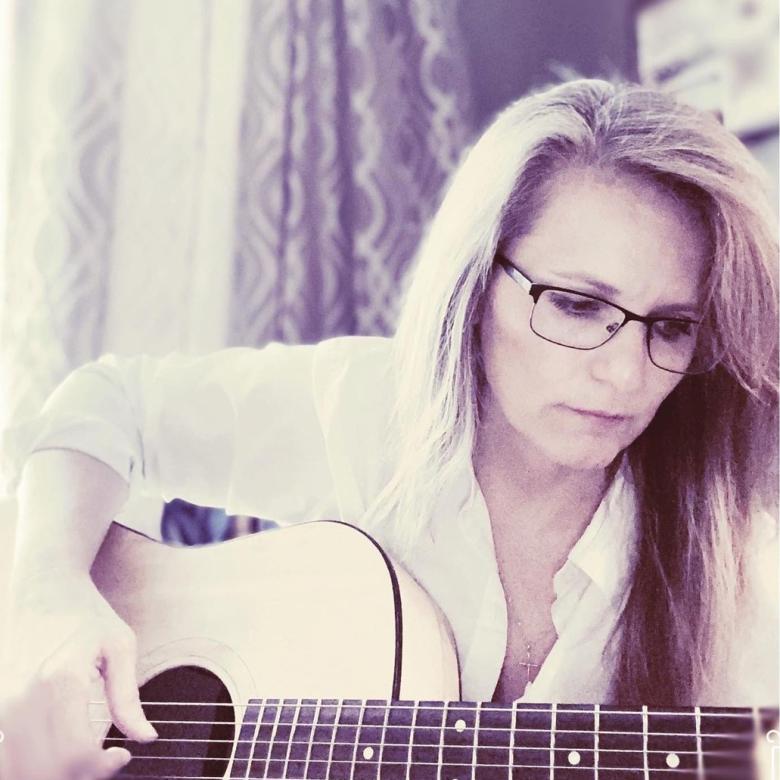
Eventually, Peggy agreed to apply and was able to replace her roof and windows and have her chimney repaired. “I mean, I can’t describe what it felt like the moment somebody knocked on my door and said, ‘We’re here to help you.’ I sobbed for hours because I was so thankful,” she says.
The repairs to Peggy’s home were possible because of Habitat’s Repair Corps program, which has been funded by The Home Depot Foundation since 2012. The program has helped more than 1,800 U.S. military veterans and their families. “The ability to make a difference in the lives of military veterans like Peggy through improved housing conditions is a priority for our company,” says Sean Vissar, The Home Depot Foundation’s manager of national programs and strategic partnerships. “It’s why we partner with Habitat to help military veterans and their families complete critical home repairs. It is a deeply meaningful way to honor the service of those who have given so much to our country.”
Now that her home is safe and healthy, Peggy looks forward to being able to share it with her children and grandchildren for years to come. “No matter where my kids go, when we talk about home, everybody’s heart is here,” Peggy says.
With her house repairs complete, Peggy can also host the group she leads that helps fellow veterans cope with PTSD through the healing power of music. Peggy teaches the group guitar and finds pride and purpose in sharing her home. “It’s helped me greatly just to have that sense of family and support coming into my home and be able to continue to make memories in the home that I love.”
